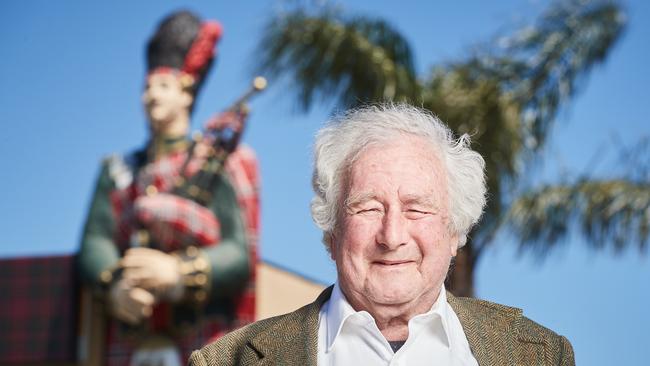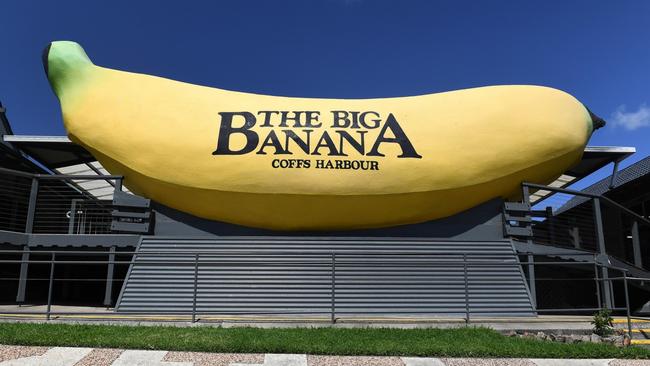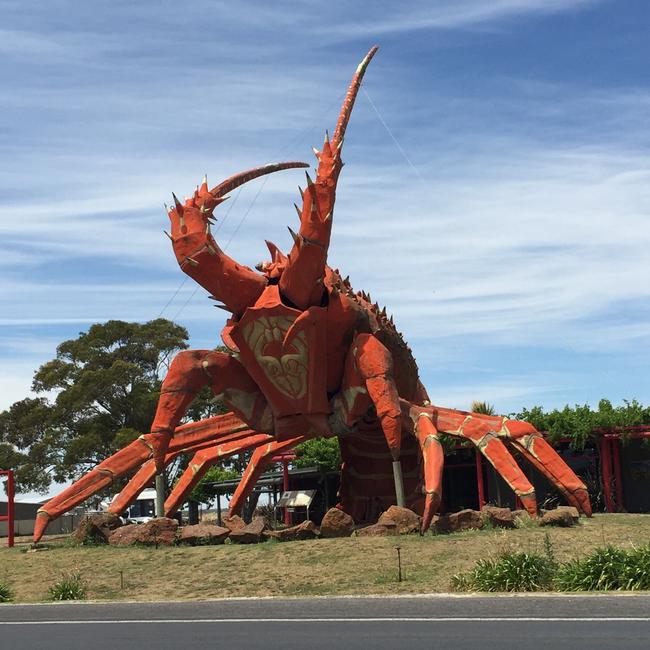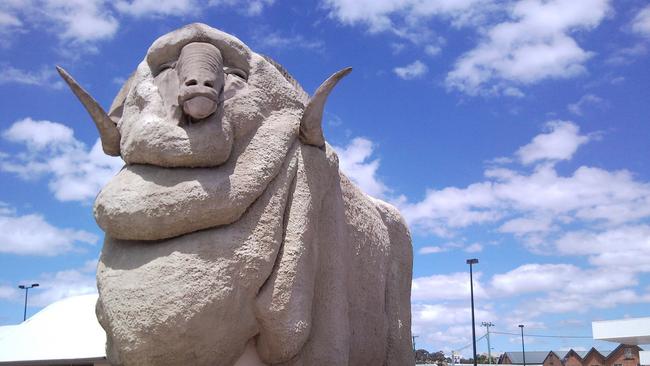Insight: South Australian artist Paul Kelly who started the ‘Big Things’ craze speaks about his iconic structures
AUSTRALIA’S obsession with Big Things didn’t start with Coffs Harbour’s Big Banana or Woombye’s Big Pineapple. It started in Adelaide, with a larger-than-life Scotsman that still stands sentinel on one of the city’s busiest intersections. The Advertiser’s Greg Barila caught up the man who started the craze.

SA News
Don't miss out on the headlines from SA News. Followed categories will be added to My News.
- Kingston’s 17m-high giant lobster and restaurant business for sale
- Larry the big Kingston lobster may be torn down
IT sent him broke, attracted unscrupulous characters who tried to claim credit for his work and created fantastic myths about one of his most beloved creations.
But Adelaide artist Paul Kelly says he has no regrets about taking on the now-iconic sculptures that inspired Australia’s obsessions with “Big Things”.
The 87-year-old, who lives with wife Pam in the Adelaide Hills, began thinking big in the early 1960s when he was commissioned to produce a giant Scotsman for a new motel on the corner of Nottage Tce and Main North Rd.
The project was announced in an article in The Advertiser in October, 1962 and the motel’s current management says the Scotsman was “in situ” by December, 1962, although it’s more likely the sculpture was unveiled sometime in 1963 - at least a year before the Big Banana, in Coffs Harbour, NSW — sometimes wrongly cited as Australia’s first big sculpture.
The internet is littered with mentions of other big things that either cite no date of construction or that list construction vaguely “in the 1960s”.
PODCAST — THE ADELAIDE MAN WHO INSPIRED AUSTRALIA’S OBSESSION WITH BIG THINGS
But Mr Kelly is adamant his Scotsman set the trend.
“That was the first in Australia,” he says. “They got onto all sorts of things after that. But that was the first one and people took their cue from that.”
Amy Clarke, a lecturer in history at Queensland’s University of the Sunshine Coast, has been tracking the history of “Big Things” trend in Australia and says the evidence seems to support Mr Kelly’s claim.
“I think the Big Banana might have been under construction when the Scotsman was finished and opened, which explains some of the confusion,” Dr Clarke says.
“I wouldn’t stake my professional reputation on it, and maybe I’m biased as an Adelaide girl, but I think the Big Scotsman was the first,” she says.
“I think it’s something we should be proud of.”
Mr Kelly says he’d never attempted a sculpture the scale of the Scotsman but read books on the subject and was spurred on by those who said it couldn’t be done.
“People said you couldn’t do it and that’s what bugged me ... I had to prove them wrong,” he said.
“People thought I was mad and I thought ‘Oh, no, bugger it all, I’ll do it. I took up the challenge and it worked”.
The project may have been difficult overall but figuring out the dimensions for the Scotsman turned out to be a cinch.
“I was working with a bloke, so every morning I’d go in and measure his foot or his hands or his arm or something, multiply it by whatever the fraction was it had to be bigger,” Mr Kelly recalled.
“It was very easy.”

Like all his major works, the Scotsman was made with a solid steel frame, which was covered in wire netting and clad in hessian.
It was then sprayed with a polyurethane foam and coated with a fibreglass mesh to prevent it from disintegrating and, finally, it was painted.
“After the polyurethane foam, you managed to get a bulk and then you got a knife onto it and shaped it with a knife so that you were hacking at this thing all the time.”
The sculpture was built in three main pieces – legs, torso and head.
“First we put the legs up, then we bolted the torso to the legs and then the head was put on last and I think the collar and a few other little things went on after that,” Mr Kely said.
“We bolted it all together and thought ‘My God, if it moves I’m going to run like hell,” he said.
“It just looked so, so big and so out of place that I didn’t know what to do. But it worked all right.”
Mr Kelly’s next piece was a decidedly smaller blue whale for a business on O’Connell St, North Adelaide.

But his most famous, and most fraught, project came along in the late ’70s — a huge lobster to sit out the front of a new tourist centre, off the main highway at Kingston SE.
“I lived next door to Ian Hannaford, the architect, and he said ‘Oh, Paul, a bloke down in Kingston wants a big lobster built. Can you do that? And I said ‘Yes, I can do that’. And it went from there,” he said.
The project took six months “from start to finish”. Mr Kelly based his designs on a lobster he had brought to him.
“I measured it and we did the drawings for it – and we ate the crayfish,” he said.
A persistent rumour has it that the lobster was originally meant to be much smaller but that Mr Kelly mucked up, confusing feet and inches with metres, making the final sculpture much bigger than intended. A claim Mr Kelly rejects as nothing more than a scurrilous rumour.
“I dispute it completely,” he says.
“What we did with the (sample) crayfish was to measure it all in inches and then multiply it and then call those feet.
“If it was an inch, it was a foot. So it went on like that. You could measure it anywhere you wanted to and that was what it was.”
“I got my friend Johnny Murray, a civil engineer, to check everything I did so that we worked it out that you could do it like this and do it like that and it would be perfectly all right.
“And he checked over everything I did – mainly for size, for strength – and he virtually OK’d it as such that it wouldn’t fall down.”

Ian Backler, who came up with the concept for Larry, and the Kingston tourist centre, says the original plan was to make the lobster look like it was “crawling over the building and people could come into the building via the tail”.
However, that plan was ultimately deemed “too expensive”.
But he agrees the story that the sculpture was originally meant to be much smaller is apocryphal.
Larry’s whole job was to seize the attention of passing tourists, so he needed to be big and “dramatic”.
“Larry is about the size we were looking for,” Mr Backler says.
“I mean, to have something only a quarter of the size really wouldn’t have had even a quarter of the pulling power for encouraging the tourists to stop and have a closer look.”
The sculpture was erected without a hitch but the project was not without its complications.
After it was finished, Mr Kelly sued Backler and his business partner, Rob Moyse, claiming about $30,000 for extra work the Kellys claimed they were owed.
But it wasn’t a happy outing. The Kellys lost their case and Mr Kelly was bankrupted.
“Yeah, that was a blight, definitely a blight – has been for many, many years.”
And the nickname Larry the Lobster? “That wasn’t mine,” Mr Kelly says.
“In the end, I called it everything but Larry,” he jokes, referring to his legal and financial woes.

But eventually he moved on, continuing his work in the plastics industry and picking up a contract to maintain illuminated signs for the ANZ Bank.
“That was the bread and butter that I had to work on,” he said.
Mr Kelly says he would have happily taken on another big sculpture, despite his experience with Larry, but the projects never presented themselves.
“Well, I was in South Australia so they didn’t come to South Australia; they went to their own state and got their own people to make it,” he said.
“I had a couple of nibbles like that but they were only nibbles, they never came to anything. I would have been prepared to do it, yes, but I didn’t get the chance.”
Asked if he feels he was given his dues for his contribution to the arts in SA and Australia’s “Big Things” culture, Mr Kelly replies: “No, none whatsoever.”
“The only thing I got was that other people had made it (my sculptures), not me.”
“There were a number of other people who came along and said ‘Oh, they’d made the same thing’ but they were telling lies. And that was rather disheartening.”
“I just shut my mind to it and thought ‘I can’t be bothered with this’.”
But for his part, he says he’s proud of his works, which he says speak for themselves, because they are still standing more than 50 years later.
“Well I’m proud of the fact that I actually did it, and there it is. Whether it falls down at some stage or other, well I’m not worried about that. It’s had its life and it was good.”
HEAPS GOOD HISTORY: LISTEN TO MORE EPISODES
You can also download episodes from iTunes or search for “Heaps Good History” in your favourite podcast app. Got a good SA story suggestion for a future episode of the podcast?



